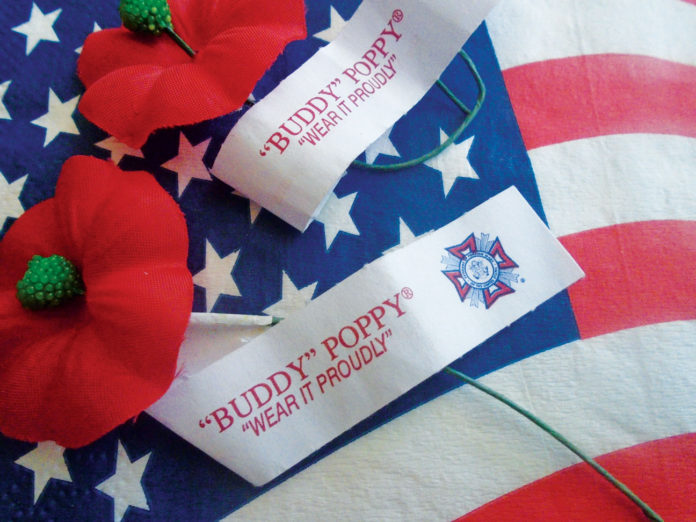It was in 1955 when the Kingston Trio first sang “Where Have All the Young Men Gone,” written by Pete Seeger about all the soldiers lost in the past wars. “When will we ever learn, when will we ever learn,” Pete wrote.
I have been looking to buy “Buddy” Poppies, but none seem to be around. These poppies are small and red in color, paper flowers, made by the Veterans of Foreign Wars in the hospitals. Small, but “mighty,” funds from the sales of these paper flowers are distributed between the Veterans Services Fund and the VFW National Home for Children. The veterans making these poppies receive a small stipend as well.
As a child in 1940, I remember my uncle buying three poppies from a veteran selling them for 5 cents apiece on the street corner of our small town in Aberdeen, Wash. World War II had reared its ugly head in Europe, and young men from our small town had disappeared from sight, drafted by the military, many never to be seen again; killed by the enemy in some foreign town.
Uncle was a Block Captain; his job was to make certain every resident on our block had their blackout curtains drawn and that no light of any kind could be detected. The town was plunged into darkness until the siren from our fire department would wail the “all clear” sound and it would be OK to raise the curtains, turn on the lights and resume our normal evening’s life.
Our home in Aberdeen was just a few miles from the seacoast town of Westport, home of a submarine fleet and 50 miles from Fort Lewis, a major army base. We were the potential target for an airstrike from the enemy.
For me as a child, this twice-a-week practice was exciting; for the children in England, France and Italy and so many other countries, the wailing sirens were real and followed by real bombs being dropped, not a practice run as I knew them to be.
The front window of our boarding house proudly displayed a 10”x15” red and white flag with a blue star in its center, hanging by a gold-braided rope with tassels on each side. These flags were issued by the military to each family who had a parent/son/daughter serving in the service.
It was the “star” itself that was the most important. If the star was blue, that denoted the family member was living and serving; if the star was white, the family member was MIA (missing in action), and if the star was gold, the family member had been killed in action. I know my aunt was terrified her flag would one day be exchanged for either a white or gold star, as did the one hanging in the window of our neighbors, the Jurasins. In 1941, their flag was replaced by one with a white star, and later that year, another flag was hung, this one with a gold star.
I remember the rest of the days I lived in Aberdeen, Mrs. Jurasin, seldom seen, only wore black; the front of their house had their curtains drawn, and weeds had overtaken Mrs. Jurasin’s flower garden.
Lives were changed forever in our small town as well as other towns throughout the world during those war years, as more flags were changed from blue to white or gold stars. We quickly learned our “Freedom” wasn’t free—it came with great cost to so many.
Military cemeteries the world over were quickly established to bury their own, plus the hundreds of thousands of U.S., Canadian, Alaskan, Mexican whose identities were unknown and lost on their soils, those bodies were never brought back to their place of origin.
Flanders Fields in Belgium holds the remains of 844 of our young men and women, with 22 sets of brothers, being buried there, side-by-side. Oh, the heartbreak of those parents.
In the Sicily-Rome American cemetery in Nettuno, Italy, there is a “Tablet of the Missing” memorial wall, which reads, “Home of the free, because of the brave.” And on that wall is the inscription: Jurasin, Philip F. Pvt. U.S Army, WWII, 2/15/1944.
Five years ago, I visited my old hometown of Aberdeen. I visited the cemetery, and walking through its mausoleum, I looked up and there was the final resting place for Kathryn and Michael Jurasin, and next to them rests Phillip, their “Gold Star” son, home at last.
As a result of the poem “In Flanders Fields,” the “Buddy” Poppy program got its start shortly after World War I by a French woman Madame Guerin, who noticed red poppies growing between the crosses of the soldiers buried in Flanders Fields.
Worried the soldiers sleeping in Flanders Fields were being forgotten too soon by the free world, she began making, selling and wearing the little red silk poppies we see today.
In 1923, here in the U.S., the newly formed American Legion adopted this “Buddy” Poppy program as its own.
Monday, May 27, is Memorial Day. Let us NOT forget those poppies blowing among the crosses in Flanders Fields, nor those men and women sleeping there. Honor them by looking for the veteran selling “Buddy” Poppies; you will be proud to be wearing one.
“We lived, felt dawn, saw sunset glow, Loved and were loved, and now we lie, In Flanders fields.”
Colly Gruczelak, a Ben Lomond resident, loves people and loves to cook. Contact her at [email protected].












